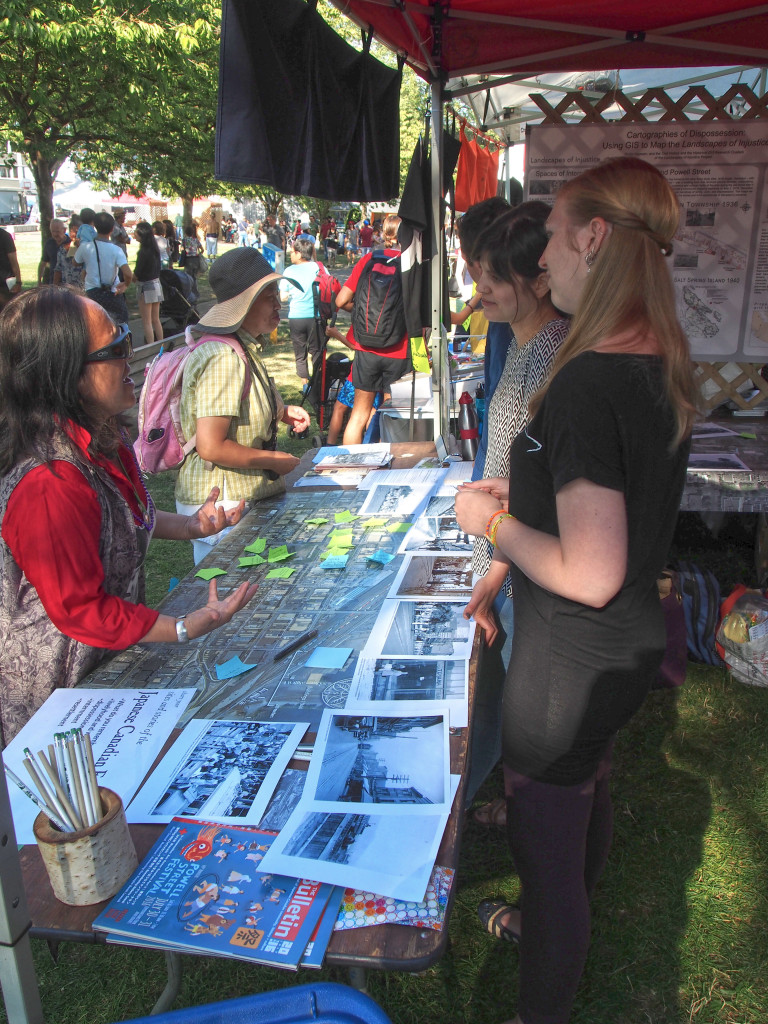 This August marked the 40th annual Powell Street Festival in Vancouver’s historic Japanese Canadian neighborhood. Landscapes of Injustice tabled booths in the indoor and outdoor venues, spoke to dozens of festival-goers, and presented the project’s headway since the previous year. Outdoors, Hide Hyodo-Shimizu Research Scholarship recipient Nicole Yakashiro challenged festival-goers to ask what different values property might have. Research assistant Alissa Cartwright presented her work developing an online database of the 1,200 Japanese-Canadian-owned fishing vessels confiscated and sold by the Canadian government in 1942 and Mikayla Tinsley talked about the timeline of the forced sale of the Tamura Building on the corner of Oppenheimer Park. On day two, our historical geographers and oral history RA ran a ‘community mapping’ workshop where participants added their memories and family stories to a historical map of Vancouver and the other study sites, Haney, Steveston and Salt Spring Island. The vibrant Powell Street Festival reflects the diverse perspectives of Japanese heritage and fosters connections within and beyond the Nikkei community; we were thrilled to join in this project.
This August marked the 40th annual Powell Street Festival in Vancouver’s historic Japanese Canadian neighborhood. Landscapes of Injustice tabled booths in the indoor and outdoor venues, spoke to dozens of festival-goers, and presented the project’s headway since the previous year. Outdoors, Hide Hyodo-Shimizu Research Scholarship recipient Nicole Yakashiro challenged festival-goers to ask what different values property might have. Research assistant Alissa Cartwright presented her work developing an online database of the 1,200 Japanese-Canadian-owned fishing vessels confiscated and sold by the Canadian government in 1942 and Mikayla Tinsley talked about the timeline of the forced sale of the Tamura Building on the corner of Oppenheimer Park. On day two, our historical geographers and oral history RA ran a ‘community mapping’ workshop where participants added their memories and family stories to a historical map of Vancouver and the other study sites, Haney, Steveston and Salt Spring Island. The vibrant Powell Street Festival reflects the diverse perspectives of Japanese heritage and fosters connections within and beyond the Nikkei community; we were thrilled to join in this project.
We also attended the Nikkei National Museum & Cultural Centre’s annual Nikkei Matsuri in September. Over the course of the weekend, tens of thousands of visitors passed through the Garden to watch the festival events, play games, and eat the delicious festival food. We set up our table next to the museum entrance. Three years into the research project we developed ‘teaser’ material to communicate our activity in small bites. These teasers spark interest, memories, and further questions. The Matsuri was a wonderful opportunity to build new connections and interest in the dispossession of Japanese Canadians’ property in the 1940s.
Photo: Research Assistants Rebeca Salas and Samantha Romano at the Powell Street festival (Credit: Ken Josephson)
